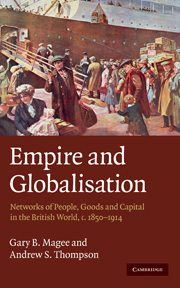Book contents
Conclusion
Published online by Cambridge University Press: 05 June 2012
Summary
This book has brought together new research in the field of cultural history with long-standing debates about the economics of imperialism. By combining approaches from the humanities and social sciences we have explored the relationship between two key features of the later-nineteenth and early-twentieth-century world: empire and globalisation. On the face of it, the division of the world into rival empires and the processes of closer international integration would appear to be inherently in conflict. To the extent that rivalry between empires, and violence and oppression within them, have pitted cultures and peoples against each other, this is true. Yet preceding chapters have also shown how the British empire, or more precisely the British World, promoted greater economic and social integration – a force for globalisation, in fact. Such a finding may seem surprising, especially when viewed through the lens of contemporary experience and national sovereignty. We are accustomed to perceive most political phenomena, including globalisation itself, through the framework of the nation state. From that perspective, closer international integration is largely a product of the interplay of different national policies. The unspoken assumption is clear: a society's freedom to make its own way in the global marketplace is contingent upon a prior ability to gain and exert its independence. If we accept this proposition, then such freedom of action cannot be attained within the structures of empire.
- Type
- Chapter
- Information
- Empire and GlobalisationNetworks of People, Goods and Capital in the British World, c.1850–1914, pp. 232 - 244Publisher: Cambridge University PressPrint publication year: 2010

